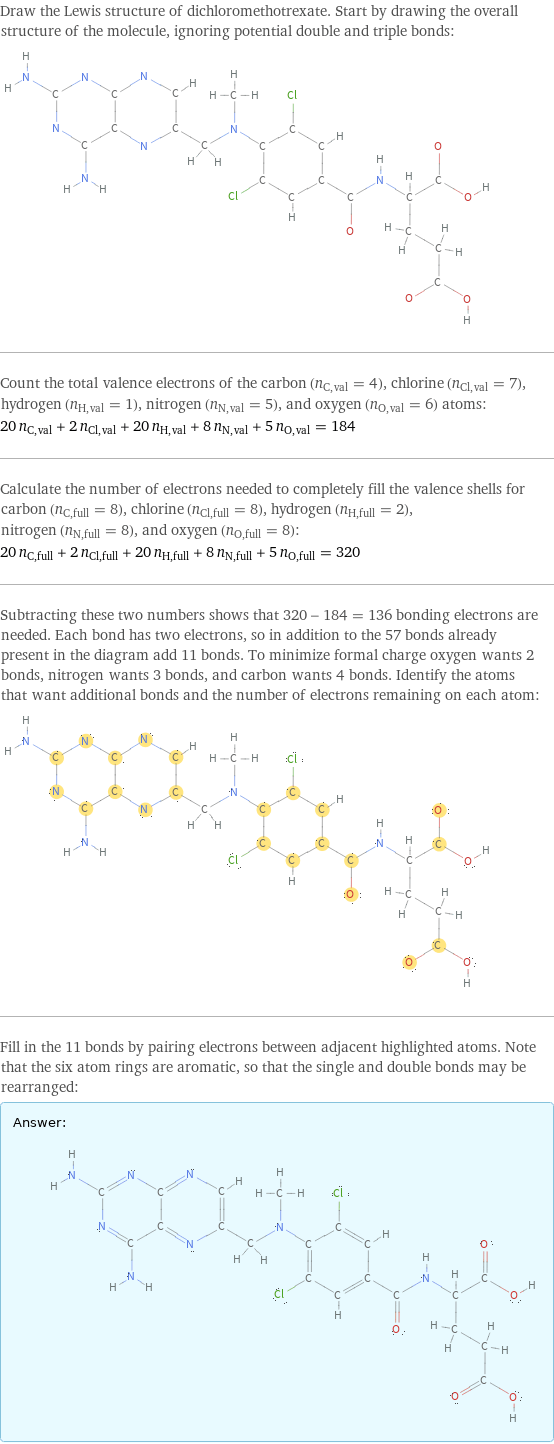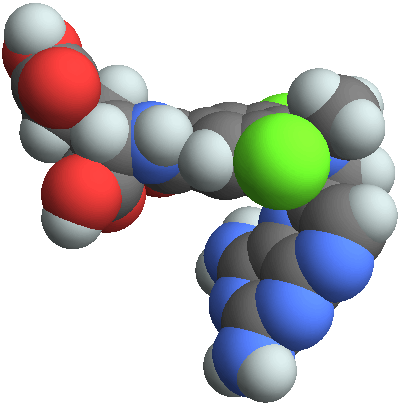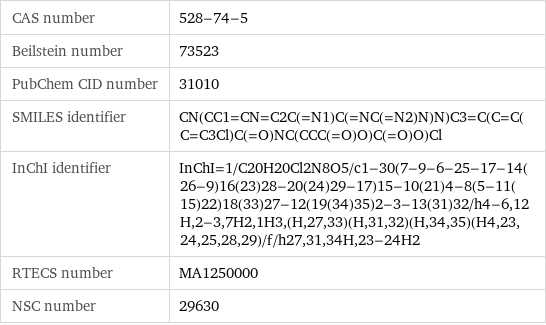Input interpretation

dichloromethotrexate
Chemical names and formulas
![formula | C_20H_20Cl_2N_8O_5 name | dichloromethotrexate IUPAC name | 2-[[3, 5-dichloro-4-[(2, 4-diaminopteridin-6-yl)methyl-methyl-amino]benzoyl]amino]pentanedioic acid alternate names | 3', 5'-dichloromethotrexate | amethopterin, 3', 5'-dichloro- mass fractions | C (carbon) 45.9% | Cl (chlorine) 13.5% | H (hydrogen) 3.85% | N (nitrogen) 21.4% | O (oxygen) 15.3%](../image_source/89796200cd446b64d42b93a8d6b96d23.png)
formula | C_20H_20Cl_2N_8O_5 name | dichloromethotrexate IUPAC name | 2-[[3, 5-dichloro-4-[(2, 4-diaminopteridin-6-yl)methyl-methyl-amino]benzoyl]amino]pentanedioic acid alternate names | 3', 5'-dichloromethotrexate | amethopterin, 3', 5'-dichloro- mass fractions | C (carbon) 45.9% | Cl (chlorine) 13.5% | H (hydrogen) 3.85% | N (nitrogen) 21.4% | O (oxygen) 15.3%
Lewis structure

Draw the Lewis structure of dichloromethotrexate. Start by drawing the overall structure of the molecule, ignoring potential double and triple bonds: Count the total valence electrons of the carbon (n_C, val = 4), chlorine (n_Cl, val = 7), hydrogen (n_H, val = 1), nitrogen (n_N, val = 5), and oxygen (n_O, val = 6) atoms: 20 n_C, val + 2 n_Cl, val + 20 n_H, val + 8 n_N, val + 5 n_O, val = 184 Calculate the number of electrons needed to completely fill the valence shells for carbon (n_C, full = 8), chlorine (n_Cl, full = 8), hydrogen (n_H, full = 2), nitrogen (n_N, full = 8), and oxygen (n_O, full = 8): 20 n_C, full + 2 n_Cl, full + 20 n_H, full + 8 n_N, full + 5 n_O, full = 320 Subtracting these two numbers shows that 320 - 184 = 136 bonding electrons are needed. Each bond has two electrons, so in addition to the 57 bonds already present in the diagram add 11 bonds. To minimize formal charge oxygen wants 2 bonds, nitrogen wants 3 bonds, and carbon wants 4 bonds. Identify the atoms that want additional bonds and the number of electrons remaining on each atom: Fill in the 11 bonds by pairing electrons between adjacent highlighted atoms. Note that the six atom rings are aromatic, so that the single and double bonds may be rearranged: Answer: | |
3D structure

3D structure
Basic properties

molar mass | 523.3 g/mol
Units

Chemical identifiers

CAS number | 528-74-5 Beilstein number | 73523 PubChem CID number | 31010 SMILES identifier | CN(CC1=CN=C2C(=N1)C(=NC(=N2)N)N)C3=C(C=C(C=C3Cl)C(=O)NC(CCC(=O)O)C(=O)O)Cl InChI identifier | InChI=1/C20H20Cl2N8O5/c1-30(7-9-6-25-17-14(26-9)16(23)28-20(24)29-17)15-10(21)4-8(5-11(15)22)18(33)27-12(19(34)35)2-3-13(31)32/h4-6, 12H, 2-3, 7H2, 1H3, (H, 27, 33)(H, 31, 32)(H, 34, 35)(H4, 23, 24, 25, 28, 29)/f/h27, 31, 34H, 23-24H2 RTECS number | MA1250000 NSC number | 29630
Toxicity properties

RTECS classes | tumorigen | mutagen | reproductive effector